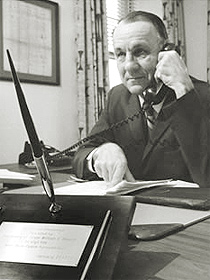Dale R. Corson facts for kids
Quick facts for kids
Dale R. Corson
|
|
|---|---|
 |
|
| President of Cornell University | |
| In office 1969–1977 |
|
| Preceded by | James A. Perkins |
| Succeeded by | Frank H. T. Rhodes |
| Personal details | |
| Born | April 5, 1914 Pittsburg, Kansas, U.S. |
| Died | March 31, 2012 (aged 97) Ithaca, New York, U.S. |
| Education | College of Emporia (BA) University of Kansas (MA) University of California, Berkeley (PhD) |
Dale Raymond Corson (born April 5, 1914 – died March 31, 2012) was an American scientist and university leader. He was a physicist, which is a scientist who studies how the universe works. He also served as the eighth president of Cornell University, a famous school in New York.
Contents
Early Life and Education
Dale Corson was born in Pittsburg, Kansas in 1914. He loved learning and earned several degrees. He received his first degree (a Bachelor of Arts) from the College of Emporia in 1934.
He then earned a Master of Arts degree from the University of Kansas in 1935. Finally, he completed his Ph.D. in physics from the University of California, Berkeley, in 1938.
His Amazing Career
Discovering a New Element
After finishing his Ph.D., Dale Corson worked at the Radiation Laboratory in Berkeley. He helped build a large machine called a cyclotron. This machine could speed up tiny particles.
In 1939, a scientist named Emilio Segrè had an idea. He thought they could use the cyclotron to create a new, unknown element. Corson, Kenneth Ross MacKenzie, and Segrè worked together. They used the cyclotron to hit bismuth (element 83) with alpha particles.
In 1940, they successfully discovered and isolated a new element! They named it "astatine" in 1947. Astatine is element 85 on the periodic table.
Joining Cornell University
In 1946, Corson came to Cornell University as a professor of physics. He helped design another powerful machine called the Cornell synchrotron. This machine is also used to study tiny particles.
He quickly moved up at Cornell. He became a full professor in 1956 and then led the physics department. In 1959, he became the dean of the College of Engineering.
Leading Cornell University
In 1969, Dale Corson became the president of Cornell University. He led the university during a challenging time. This included the final years of the Vietnam War, when many students were protesting. He also guided the university through a tough economic period in the 1970s.
His main goal was to bring stability back to Cornell. He wanted the university to focus on its core missions: research, teaching, and learning.
- He helped bring together the state-supported and privately funded parts of Cornell. This made the university stronger.
- He supported important research centers like Arecibo (a famous observatory) and the Wilson Synchrotron Laboratory.
- He also helped create the Cornell NanoScale Science and Technology Facility in 1977. This center studies very tiny structures.
- He improved departments like Geology and Biological Sciences. He also added new study programs, such as Medieval studies.
- The Herbert F. Johnson Museum of Art, designed by a famous architect, was finished during his time.
- He encouraged programs that combined different subjects, like Science, Technology, and Society.
Supporting Women and Minorities
Dale Corson made big improvements for women on campus.
- A Women's Studies Program was officially started in 1972.
- He created a special committee to suggest ways to improve the status of women.
- Cornell's rules for admission were changed to include gender as a protected group. This meant women could not be discriminated against.
- More women were hired as professors and in leadership roles.
He also strongly supported the Africana Studies and Research Center. This center grew from the black studies movement. He also suggested forming an Affirmative Action Advisory Board. This board would check on the status of women and minorities and suggest ways to help them.
Changes in University Governance
During his presidency, how the university was run also changed.
- A University Senate was created, including students, faculty, and employees.
- Students and employees were added to the Board of Trustees, which makes big decisions for the university.
- New rules for student behavior and a new campus justice system were put in place.
Helping the U.S. Space Program
Dale Corson also played a key role in the early days of the United States space program. He served on a special committee called the Stever Committee. This committee worked to bring together different parts of the government, private companies, and universities. Their goal was to use everyone's knowledge to develop a space program for the U.S.
Scientific Contributions
Dale Corson was also known for his scientific writing. He co-authored an important textbook on electromagnetism, which is the study of electricity and magnetism.
- Corson, D.R. and Lorrain, P. Introduction to electromagnetic fields and waves, W. H. Freeman, 1962.
- Lorrain, P. and Corson, Dale R. Electromagnetic Fields and Waves, 2nd ed., W. H. Freeman, 1970 (ISBN: 0-7167-1823-5).
As mentioned, he was a co-discoverer of the element astatine. In 1987, he received the Public Welfare Medal from the United States National Academy of Sciences. This award honors people who use science for the public good.
See also
 In Spanish: Dale R. Corson para niños
In Spanish: Dale R. Corson para niños

